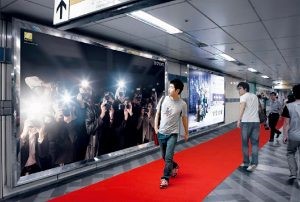An exhibit provides the perfect platform to shape how someone feels towards a brand. Turning your exhibit into an experiential experience is a smart way to capitalise on your trade show investment.
When most people think about experiential experiences they automatically assume it is something fancy reserved purely for the big end of town with deep pockets. In a trade show environment, you’re already part way there… You have your audience who is actively seeking to learn what’s new and explore. It’s 100% up to YOU how that experience unfolds (the fun part).
You could, do what’s expected and hide behind a counter, thrust a brochure at someone or look like you’d rather be somewhere else.
… OR …
You could create a memorable encounter.
The secret to creating an experiential experience is making one that is authentic. It makes you memorable and reinforces why they should be doing business with you. You’re meeting them face-to-face and letting them eyeball the people behind your brand, which increases trust and is hands down why exhibitions work so damn well.
Here are some interesting statistics from the EventTrack Survey pre-Covid. While things have changed since then, it’s a good guide to what you could expect from the show floor.
- 62% said consumers gained greater product knowledge as a result of their experiential event
- 57% developed deeper consumer involvement
- 74% were more likely to purchase a company’s products or services after an experiential marketing event
Why experiential marketing works so well
The business’s that get real cut-through are breaking away from the pack are re-introducing the “human factor” (Yep, our highly technical term). It’s our detachment from the real world and any mundane, expected transactional experiences that means experiential experiences work so well.
“Most businesses are obsessed with downplaying Mystery. They are determined to frame the world so it fits their own systems and processes.”
– Kevin Roberts, CEO Worldwide, Saatchi & Saatchi
We are all so busy being busy that when a genuine exchange takes place it can be a refreshing slap in the face. It’s raw, juicy and people lap it up. If you take the time to connect with your market at an exhibition you will be rewarded a million times over. This has now become our biggest challenge.
Giving your brand human qualities like vulnerability or sharing a value or belief allows a brand to become far more relatable to those humans walking the show floor. Something special happens when you take one of these concepts and get creative with how you translate your message through your exhibit.
… You invite people to explore. (We all LOVE to explore)
This really is the secret to getting them to let their guard down and open their minds to something new. The moment you think experiential, there’s a good chance you think about a campaign like one of these:
Is it for me?
At its core, experiential marketing is about creating a memorable hands-on experience with your brand. Following a rise in mass marketing, it’s the strength of the connection each of us have with a brand that is now a highly sought-after commodity.
How can you stand out from the crowd and be seen as a business who cares and is authentic rather than one focused solely on sales transactions?
Giving back to the community is one way that people have demonstrated this in an experiential setting. Either in the form of donations for completing an activity or a feel good story showcasing how your company is helping in the community. This has been a trend that has really taken off with pharmaceutical exhibits because they can’t even give a pen away any more without raising eyebrows! (If I was a Dr, I’m not sure I could be bribed by a pen… But, them be the rules.)
It could be theming that transports the visitor outside of the show floor. Or an activity to break up the incredibly ordinary experience of walking the aisles.
To me, experiential marketing relates to how we want the people to interact with the brand and feel as they walk away having had their experience. This is why we put such a strong emphasis on what we want from the visitors before mapping out an experience that is integrated into a complete exhibit strategy.
It’s only after knowing what a client is trying to achieve (the goal) that we will ever consider the structure that would best represent the business and create the mood or behaviours we want from the visitor.
5 questions to ask before creating your experiential experience:
- Do you want to provoke thoughts?
- Engage senses to feel a particular way?
- Get them to behave in a certain way?
- Relate, shock, excite, amaze, grab their attention?
- Or is it a purely indulgent experience you want them to enjoy?
Another example: Nikon’s paparazzi ad a few years back led commuters at a subway in South Korea along a red carpet that led them to the Nikon store. The graphic itself is brilliant in its simplicity, but it also had a sensor that tripped set of flashes of those passing by, making them feel like the stars of the show.

The approach you take doesn’t have to be outrageously obvious either. The funny part is that it’s actually doing the opposite to what people expect that usually works best. When it comes to the basics, lighting, product layout and signage are just as important at influencing outcomes. Eg, if you want visitors to be able to direct themselves you would need a hierarchy of signage. They would need to see the subject, then the category, product grout etc so it filters down to the product they are interested in.
In the computer software market they have successfully cut out middle men while reducing costs and increasing accessibility. We now go to the app store to search for a program online, download the app, pay online and even search for help when troubleshooting. Boy, do they have us trained well! The whole experience is very different to getting in your car, talking to someone at a store, paying over the counter, flicking through a physical manual and dealing with multiple discs to install your software like we had to…
What about the famous Genius Bar at the Apple Store? Rather than naming it the “Repairs, Issues & Faulty Goods Centre” or “Customer Support” they cleverly went a completely different route with the “Genius Bar”, which drastically alters public perception and therefore the experience they have with the brand before they even set foot in the store. Brilliant choice of words. Well played, Apple.
If you really want to make a difference to the impact you make with your exhibit, take a giant step back and look at WHAT you’re telling your audience and HOW you’re doing it. If you knew nothing about your business or your product, would you want to find out more? Once you get a clear idea of your message you can get creative with your implementation.
Despite being told not to “judge a book by its cover”, it’s human nature to and we are doing it unconsciously everyday. Sometimes we are just too close to our business to be able to see what outsiders see. If you would like help creating your next experiential experience at an exhibition, get in touch and let’s have a no-obligation call.
Yours in Exhibiting,
Jess
